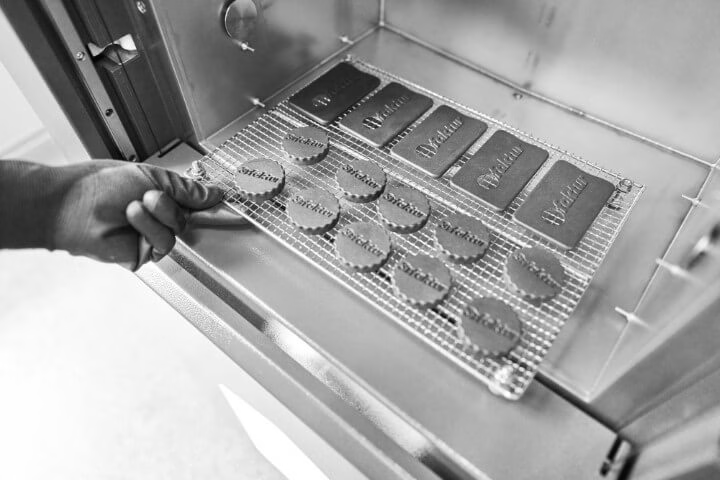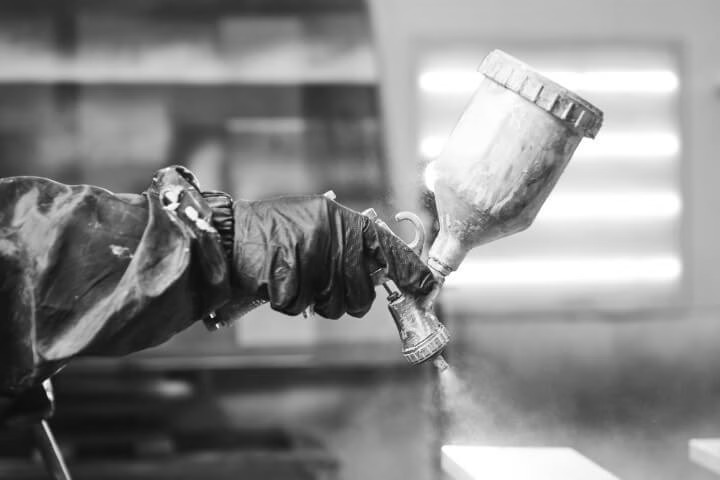Polyamide 12 (PA 12) is a technically advanced, rigid plastic specifically developed for additive series production. The thermoplastic material convinces with high mechanical strength, thermal stability, chemical resistance, and low unit costs – ideal for functional parts in industrial use. We process the material in various options using the Multi Jet Fusion process.
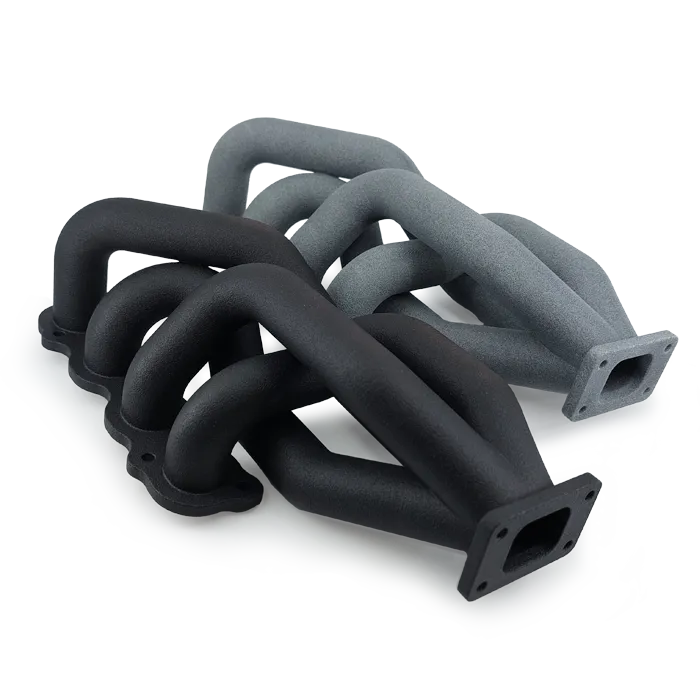
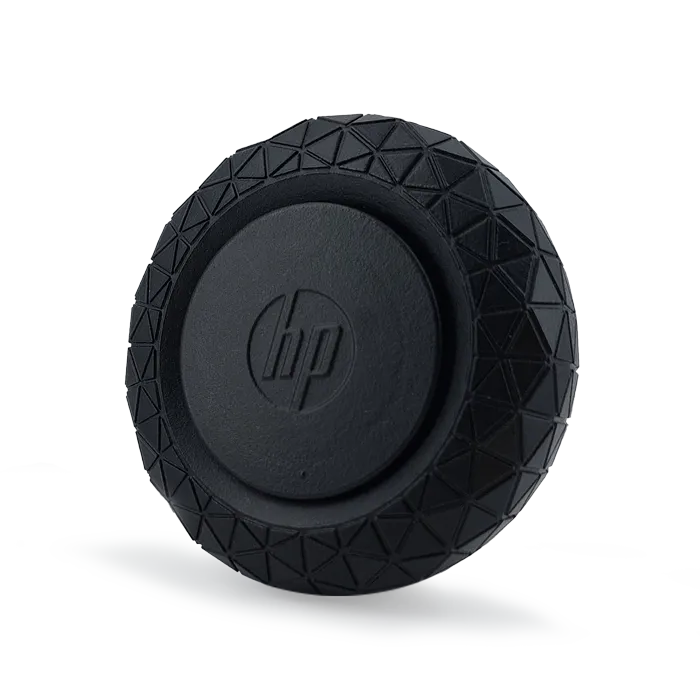
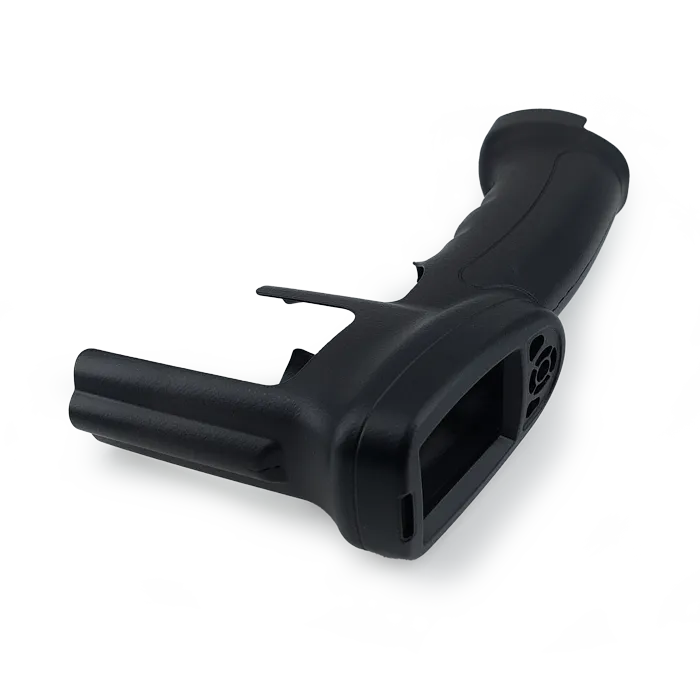
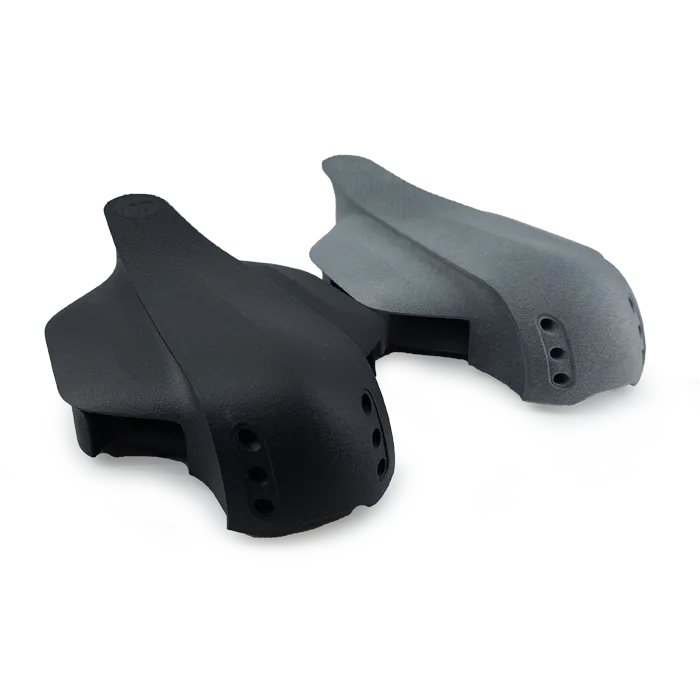
Quick Facts
Technology
Multi Jet Fusion
Colors
gray, black;
white, multicolor (only PA 12 | White)
Build Volume
380 x 284 x 380 mm
Production Time
3 working days (Prio)
6 WD (Standard)
12 WD (Flex)
Accuracy
± 0.3 %
(min. ± 0.3 mm)
1. Our PA 12 Options
By using different raw materials and production-specific parameters, a wide range of properties is created – from particularly economical to high-strength or visually refined. For every requirement, you will find the right PA 12 variant with us.

PA 12 | Classic
Our industry-leading standard since 2017:
The established PA 12 solution: consistent material quality and high process reliability – ideal for series production and long-running projects.
More information
APPLICATION
Universal option for (almost) all components in visible and non-visible areas.
COST
$$$$$
STRENGTH
★ ★ ★ ★ ☆
SURFACE
★ ★ ★ ★ ☆

PA 12 | Essential
Our most economical option: Essential offers a robust balance between cost and quality – the ideal choice for functional prototypes and cost-efficient small series.
More information
APPLICATION
Rather compact components with a focus on cost-efficiency.
COST
$$$$
STRENGTH
★ ★ ★ ☆ ☆
SURFACE
★ ★ ★ ☆ ☆

PA 12 | Smooth
Our best surface finish: Thanks to an especially fine raw material, a smooth and homogeneous feel is achieved – ideal for visible components in housings, devices, or control elements where appearance matters.
More information
APPLICATION
Visible parts, including bulky ones, such as housings.
COST
$$$$
STRENGTH
★★ ★ ☆ ☆
SURFACE
★★★★ ☆
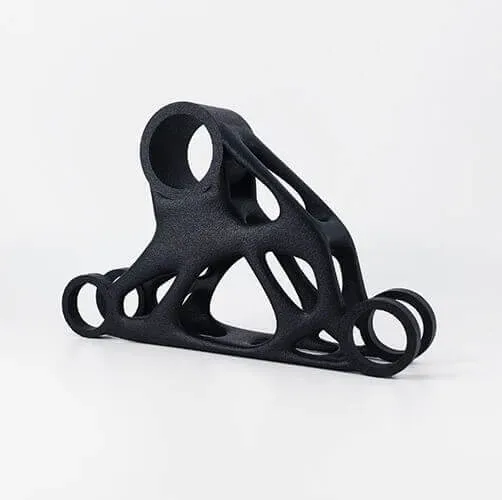
PA 12 | Performance
Our most powerful option: Optimized material and printing parameters ensure maximum durability and dimensional stability – recommended for stressed functional parts.
More information
APPLICATION
Parts with increased requirements for mechanical load.
COST
$$$$
STRENGTH
★★★★ ★
SURFACE
★★★★★ ☆
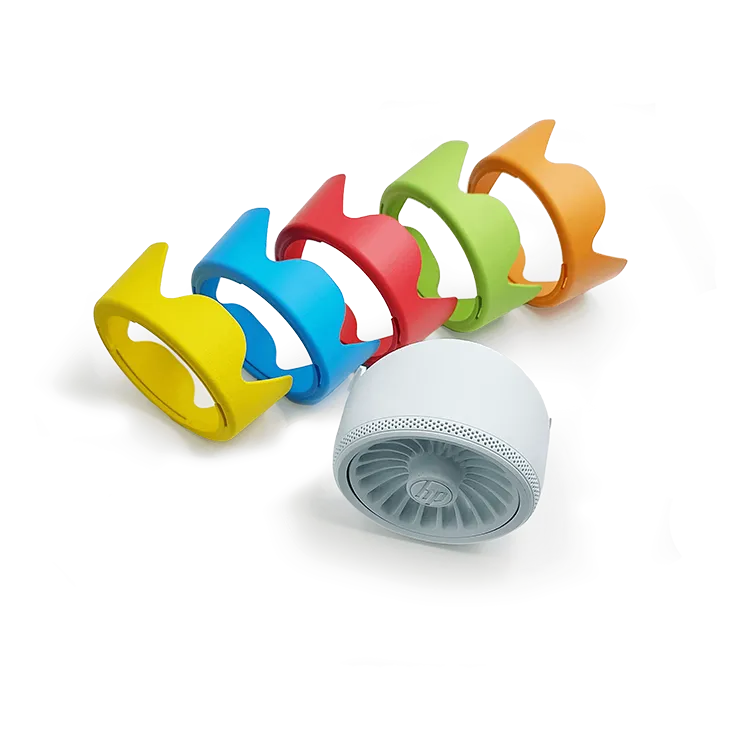
PA 12 | White
Our widest color range: “PA 12 W” has a white base color and can be dyed in various colors. This makes it the ideal material for visible parts with color requirements or components in industrial signal colors.
More information
APPLICATION
Visible components with color requirements.
COST
$$$$$
STRENGTH
★★★ ★ ☆
SURFACE
★★★★ ☆
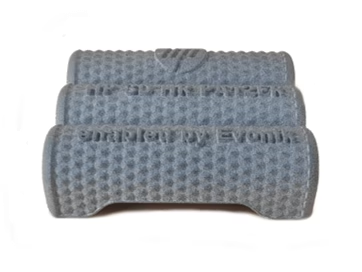
PA 12 | FR
Our flame-retardant option: “PA 12 FR” is a flame-retardant version of PA 12 and meets the UL 94 V0 classification from 2.5 mm wall thickness. It is suitable for applications with increased safety requirements, particularly in electrical and transportation environments.
More information
APPLICATION
Components with flame-retardancy requirements.
COST
$$$$
STRENGTH
★★★ ☆ ☆
SURFACE
★★★★ ☆
2. PA 12 Variants in Detailed Comparison
2.1. General Variants
PA 12 | Classic
Our standard for proven series quality.
MANUFACTURER / PRODUCT
Evonik / HP 3D HR PA 12
COLORS
Gray, Black
LAYER THICKNESS
80 µm
PRINT MODE
Balanced
SYSTEM
HP MJF 5210
GENERAL TOLERANCE
±0.30 mm or ±0.3%
PRODUCTION TIME
Prio: from 3 WD
Standard: from 6 WD
Flex: from 12 WD
PA 12 | Essential
Best cost-efficiency without sacrificing industrial usability.
MANUFACTURER / PRODUCT
Evonik / HP 3D HR PA 12
COLORS
Gray, Black
LAYER THICKNESS
120 µm
PRINT MODE
Fast
SYSTEM
HP MJF 5210
GENERAL TOLERANCE
±0.3 mm or ±0.3%
PRODUCTION TIME
Prio: from 3 WD
Standard: from 6 WD
Flex: from 12 WD
PA 12 | Performance
Maximum mechanical performance for high technical requirements.
MANUFACTURER / PRODUCT
Evonik / HP 3D HR PA 12
COLORS
Gray, Black
LAYER THICKNESS
90 µm
PRINT MODE
Robust (“Balanced 56”)
SYSTEM
HP MJF 5620
GENERAL TOLERANCE
±0.3 mm or ±0.3%
PRODUCTION TIME
–
Standard: from 6 WD
Flex: from 12 WD
PA 12 | Smooth
Finest surface for visible parts.
MANUFACTURER / PRODUCT
Arkema / HP 3D HR PA 12 S
COLORS
Gray, Black
LAYER THICKNESS
80 µm
PRINT MODE
Custom
SYSTEM
HP MJF 5620
GENERAL TOLERANCE
±0.3 mm or ±0.3%
PRODUCTION TIME
Prio: from 3 WD
Standard: from 6 WD
Flex: from 12 WD
2.2. Variants with Special Properties
PA 12 | White
More color variety for visible parts.
MANUFACTURER / PRODUCT
Evonik / HP 3D HR PA 12 W
COLORS
White, Colored
LAYER THICKNESS
80 µm
PRINT MODE
Balanced
SYSTEM
HP MJF 5420
GENERAL TOLERANCE
±0.3 mm or ±0.3%
PRODUCTION TIME
Prio: –
Standard: from 7 WD
Flex: –
PA 12 | FR
For maximum safety: flame-retardant, certified, industry-proven.
MANUFACTURER / PRODUCT
Evonik / HP 3D HR PA 12 FR
COLORS
Gray
LAYER THICKNESS
90 µm
PRINT MODE
Balanced
SYSTEM
HP MJF 5620
GENERAL TOLERANCE
±0.3 mm or ±0.3%
PRODUCTION TIME
Prio: –
Standard: from 10 WD
Flex: –
3. Polyamide 12: One Polymer, Numerous Applications
Polyamide 12 (PA 12) stands for durability, high load capacity, as well as exceptional thermal and chemical stability. These properties make the material the first choice for demanding applications in:
- Industry & High-Tech
- Medical Technology
- Automotive & Vehicle Construction
- Electronics
- Optics
- Consumer Goods
Thanks to state-of-the-art manufacturing processes, 3D-printed PA 12 components – depending on the process option – achieve almost the same mechanical and functional properties as injection-molded components.
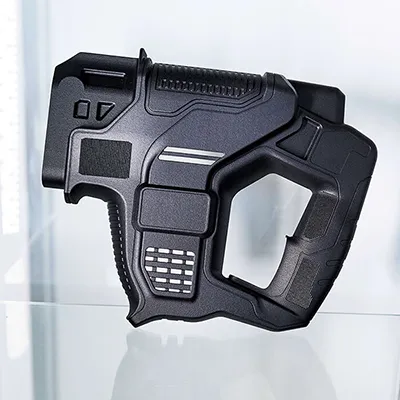
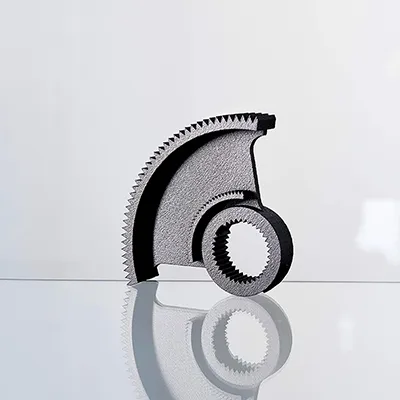
Mechanical Parts
PA 12 is flexible when thin-walled, rigid when thick-walled, abrasion-resistant – ideal for gears, connectors, propellers, and more.
Recommended variants: PA 12 | Performance or Classic, optionally combined with chemical smoothing for thin, dynamically loaded, or friction-intensive parts.
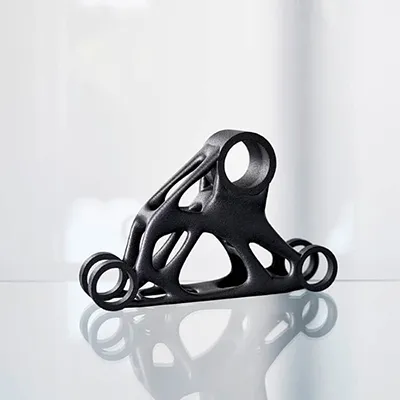
Structural Components
PA 12 enables freely designable, resource-efficient mounts – from circuit board to motor brackets – highly optimized with minimal material usage.
Recommended variants: PA 12 | Essential
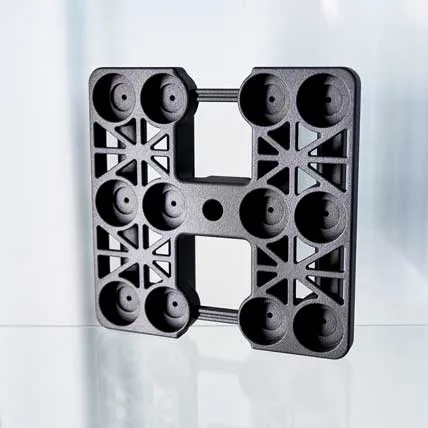
Tools & Fixtures
The production method enables fast manufacturing of complex fixtures. The material is, among others, oil-resistant and can withstand both thermal and mechanical stress.
Recommended variants: PA 12 | Performance (for dynamic load or thin walls), Essential or Classic.
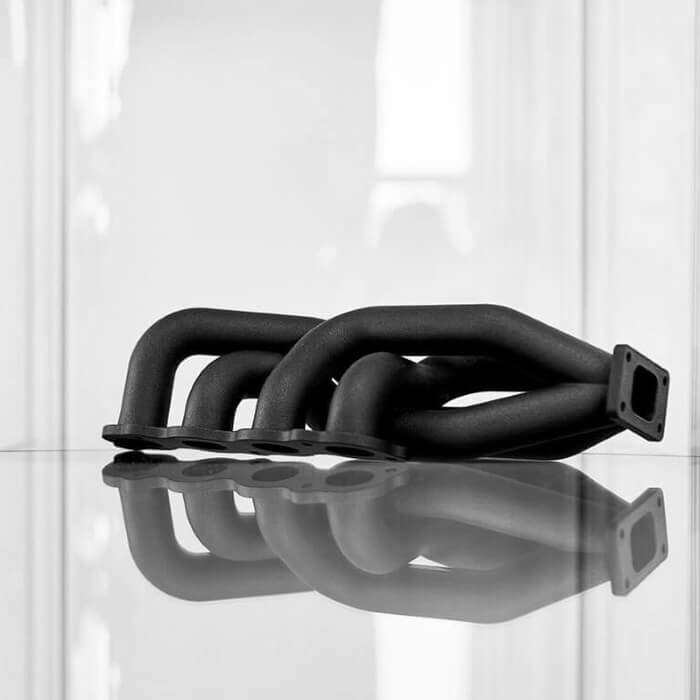
Gas-Conducting Systems
PA 12 allows the production of complex internal channels and integrated connectors in a single print job – without assembly. For absolutely leak-proof channels, we work with you to ensure the design-dependent minimum channel diameter.
Recommended variants: PA 12 | Classic or Essential combined with Chemical Smoothing.
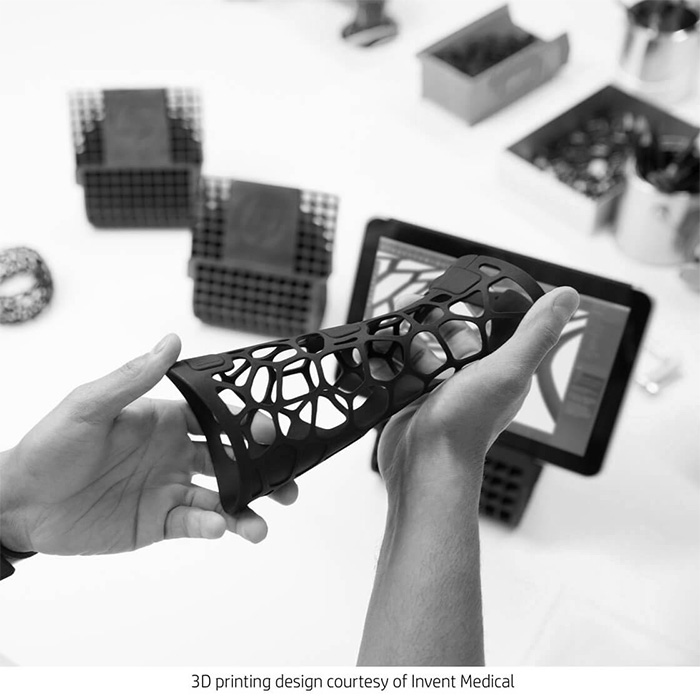
Orthoses
PA 12 enables patient-specific shapes, is skin-friendly and extremely durable – perfect for long-lasting orthoses. For flexible areas, we additionally recommend elastic TPU.
Recommended variants: PA 12 | Classic, Smooth, White or Performance, depending on the application.
4. Polyamide 12: Finishing & Post-Processing
Coloring
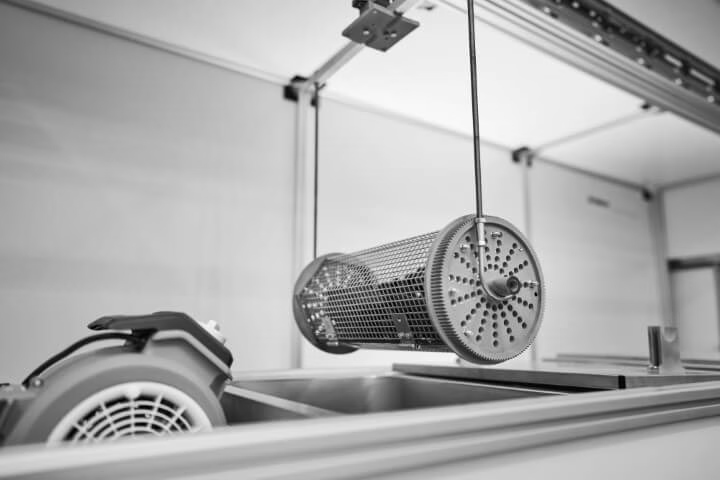
- Standard Dyeing Black: for all variants except PA 12 | White
- DeepDye Dyeing Black: for all variants except “White”
- DeepDye Dyeing Colored: for PA 12 | White
Note: According to Bluecard, no additional finishing steps are permitted for PA 12 | FR.
5. Polyamide 12: Mechanical, Thermal and Electrical Key Figures
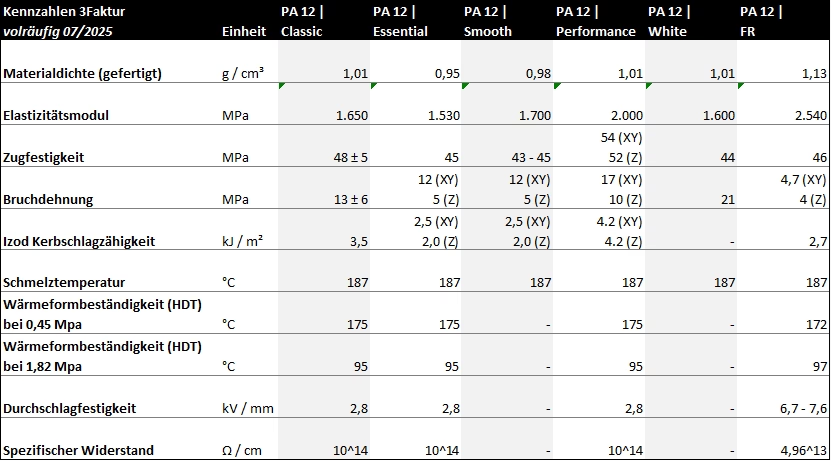
6. Polyamide 12: Chemical Resistance
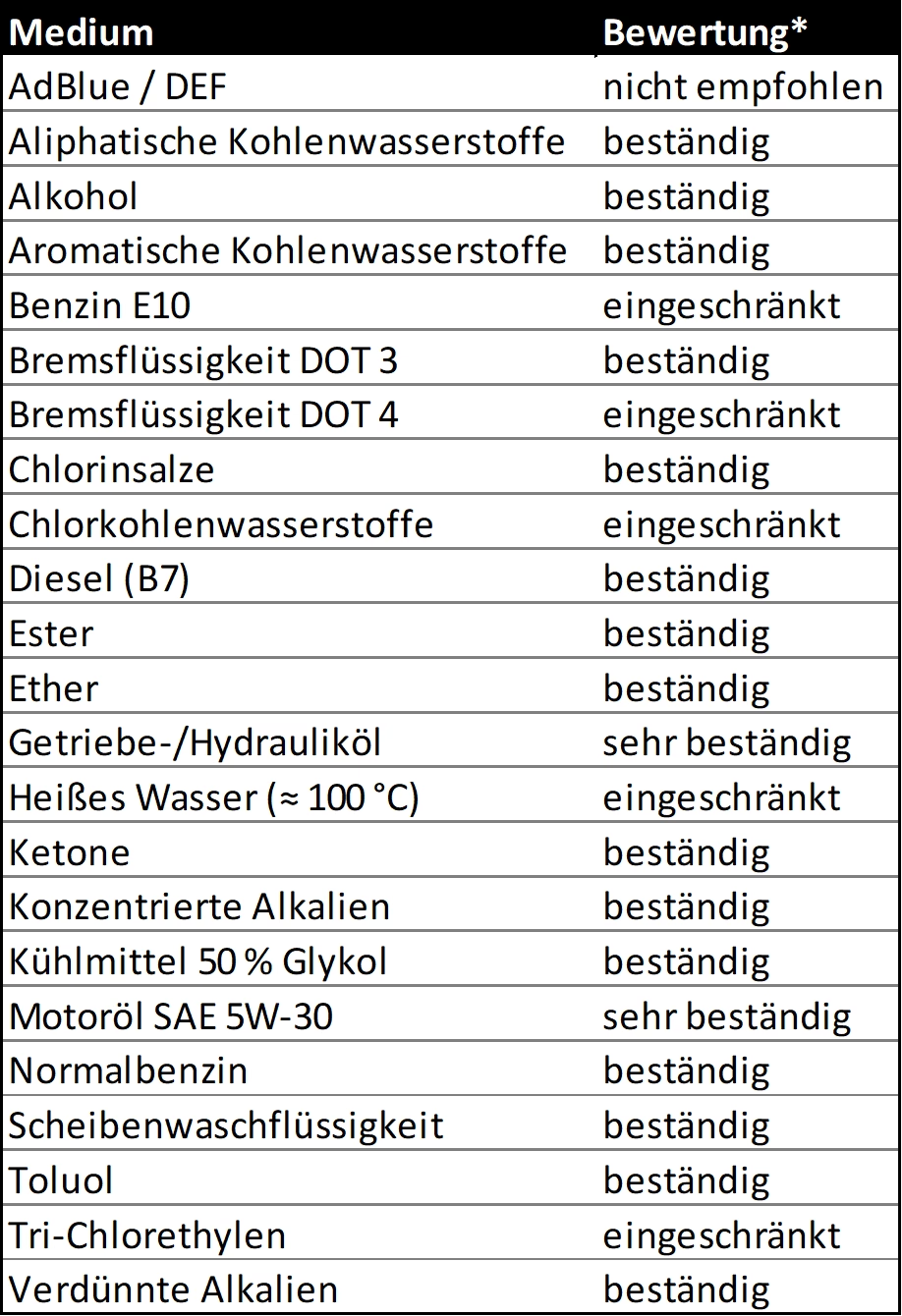
HP Multi Jet Fusion PA 12 is characterized by exceptionally high resistance to non-polar media. Engine, transmission and hydraulic oils, diesel as well as common coolants and windshield washer fluids hardly affect the material even under continuous exposure – dimensional stability and mechanical properties remain almost unchanged.
With strongly polar liquids, e.g. brake fluid (DOT 4), PA 12 absorbs a small amount of mass and loses strength. For critical sealing areas, we recommend thin barrier coatings or constructive safety margins.
PA 12 | White is also sterilization-resistant: steam, EtO, gamma and e-beam cycles cause only minimal changes (< 10% strength loss, ΔE < 2). This makes PA 12 ideal for reprocessable medical devices and functional parts in the food & life science sector.
Polyamide 12 therefore offers a wide range of applications – from heavily loaded automotive components to fluid handling systems to medical devices.
* Notes on interpretation
- Resistant = < 5% property change or manufacturer rating “Good”.
- Limited = 5–15% property change or “Moderate” → application possible, but protection via coating or safety margin recommended.
- Not recommended = > 15% property change or significantly impaired mechanics.
7. Polyamide 12: UV Stability
Although PA 12 is overall a very robust material, prolonged UV exposure also leads to aging effects here. The following table gives you a compact overview of the UV resistance of the individual PA 12 variants.
HP HR PA 12 enabled by Evonik
PA 12 | Classic
PA 12 | Essential
PA 12 | Performance
UV Resistance
Good: The base polyamide withstands short-term radiation, but ages visibly under permanent outdoor exposure (discoloration, embrittlement).
Practical Notes
For permanent outdoor use, provide black coloring or clear coat/PU coating.
HP HR PA 12 W enabled by Evonik
PA 12 | White
UV Resistance
Very Good: The white powder contains a light-stable additive package that protects the material against yellowing for a long time.
Practical Notes
With long-term exposure, yellowing may eventually occur, which can be reduced by coloring or coating.
HP HR PA 12 S enabled by Arkema
PA 12 | Smooth
UV Resistance
Very Good: PA 12 S is based on a specially modified PA 12 system with UV additive.
Practical Notes
The material is ideal for continuous outdoor use. Here too, at least black coloring is recommended.
8. Polyamide 12: Design Guidelines
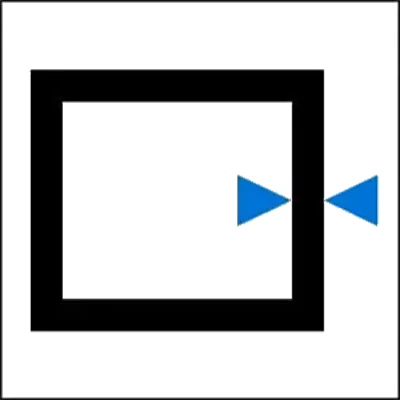
Wall Thicknesses
Minimum Wall Thicknesses
- PA 12 | Classic, PA 12 | Performance, PA 12 | White: 0.7 mm
- PA 12 | Essential; PA 12 | Smooth: 1.0 mm
For free-standing walls or extrusions as well as for larger surfaces, the wall thickness should be increased accordingly.
Maximum Wall Thicknesses
From approx. 6 mm wall thickness, we insert a lattice structure into models before printing. For some variants (Classic, Performance, White) you can opt out of this. More info on lattice structures can be found here.
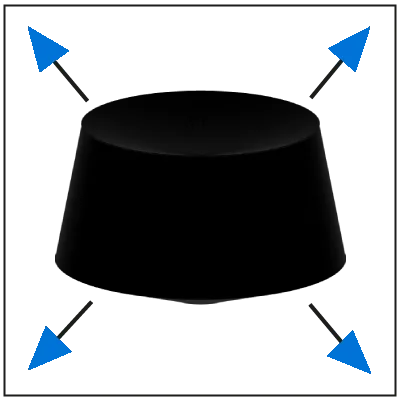
Size
Maximum Size
The maximum size for all variants is 370 x 274 x 380 mm.
Minimum Size
The detail resolution of very small parts is limited. We recommend that at least one dimension of the part exceeds 10 mm.
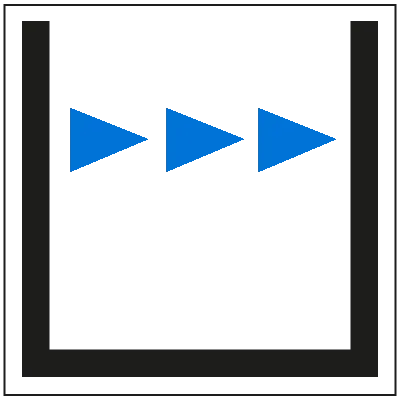
Clearances
Maintain a minimum clearance of 0.5 mm between two walls (applies to all variants).
Individual objects (“shells”) must always be uploaded as separate files if they are not firmly connected.

Resolution
Details down to a size of approx. 0.5 mm (guideline value) can be displayed.
Variants with better surface quality, especially PA 12 | Smooth, can also be slightly smaller, whereas PA 12 | Essential has reduced resolution.

Interlocking Objects
Interlocking objects can be printed in all variants.
Please note the minimum clearance between objects of 0.5 mm and ensure that the corresponding areas are accessible to remove excess material powder.

Hollow Parts
Hollow objects can be printed in all variants, but openings (min. 10 mm diameter) must be added so that excess material can be removed.
For larger cavities, you should plan several openings. The raw material is highly compacted during the printing process, so removing excess material is very difficult.
9. Your Quote at 3Faktur
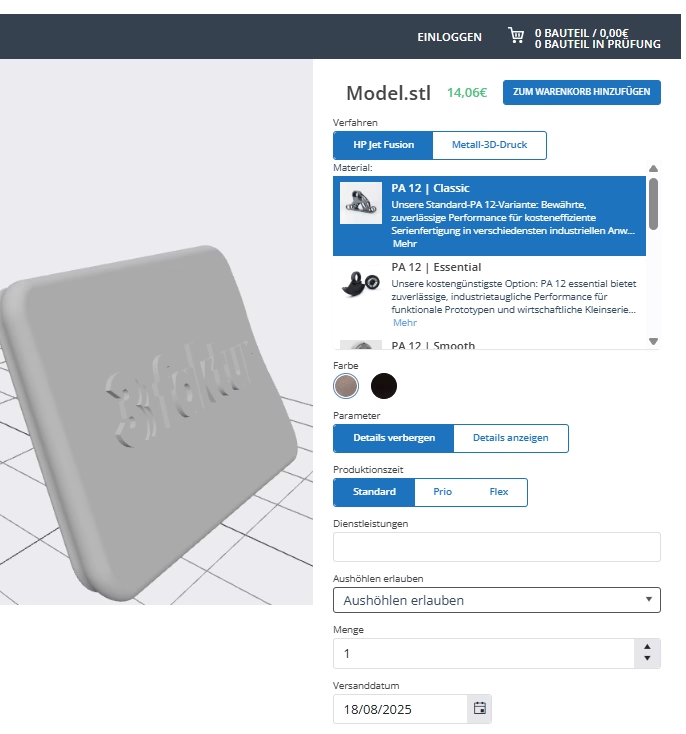
Upload your 3D data in STEP or STL format – our online tool automatically analyzes it and generates your individual instant quote within seconds.
Need advice for your project? Our customer service will be happy to advise you.
